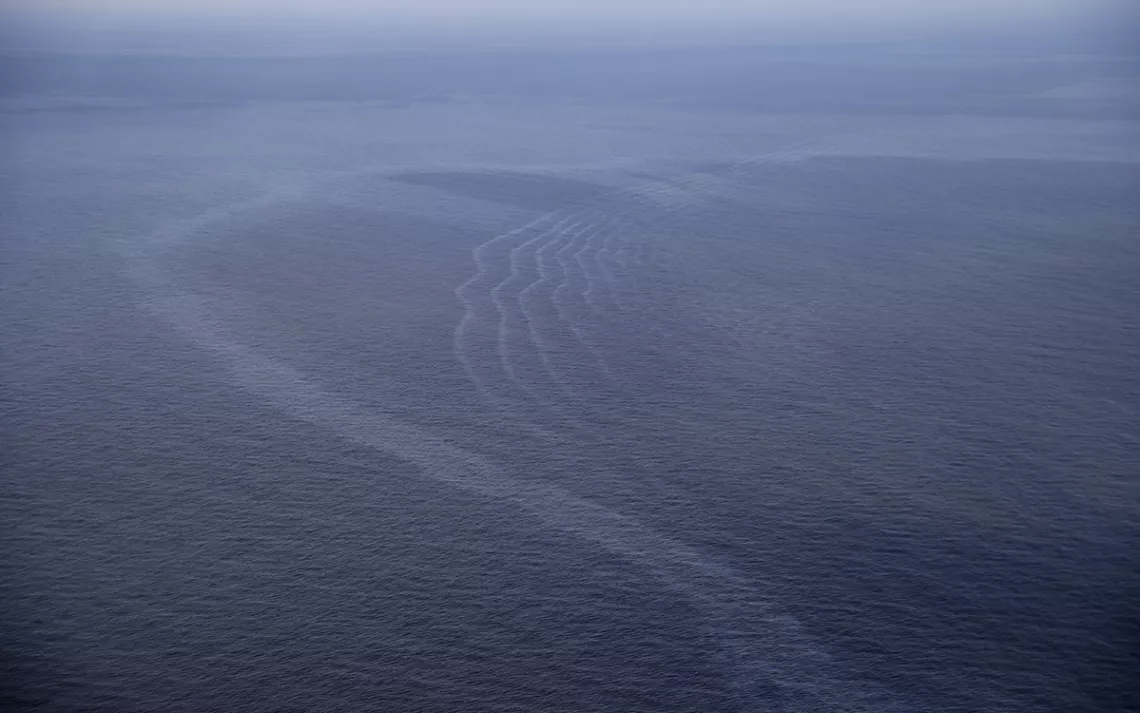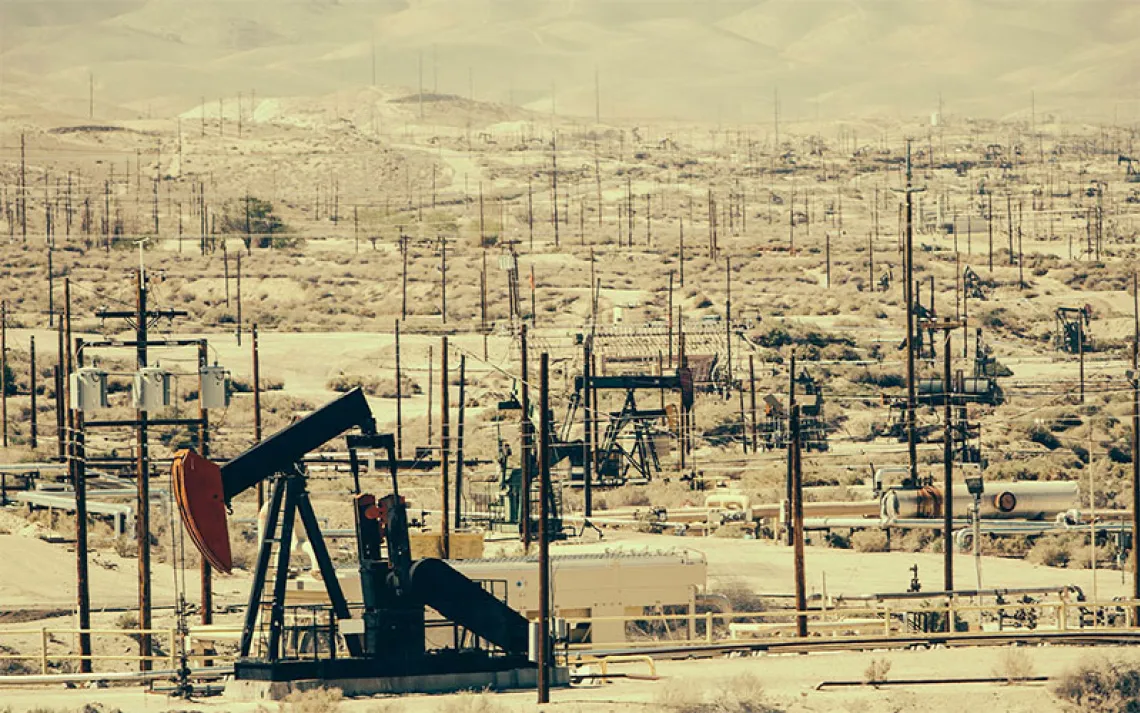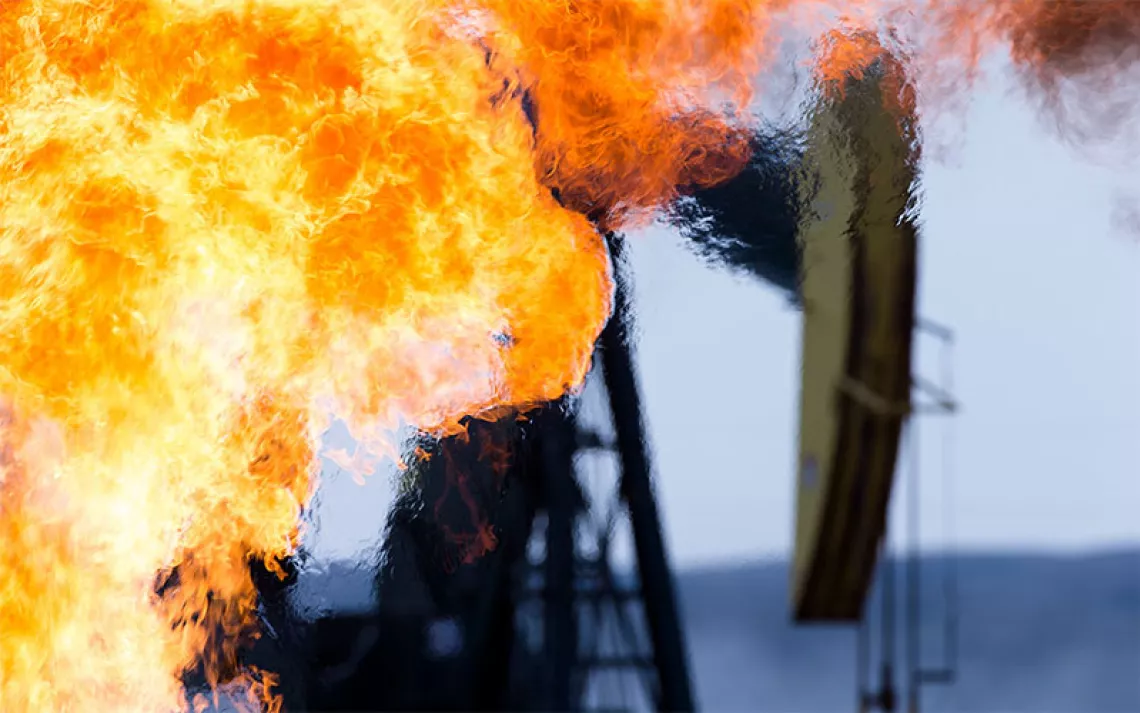The Longest-Running Offshore Oil Spill You’ve Never Heard About
The Taylor oil spill in the Gulf of Mexico is a cautionary tale

This March 31, 2015, aerial photo shows an oil sheen drifting from the site of the former Taylor Energy oil rig in the Gulf of Mexico. | Photo by AP Photo/Gerald Herbert
When a hurricane is gathering force in the Gulf of Mexico, the national media tends to track the storm with a focus on New Orleans. This was especially true in August, as Hurricane Laura spiraled toward the coast a week shy of the 15th anniversary of Hurricane Katrina. While this view of the Gulf region has an obvious media logic, it’s shallow and shortsighted. A more honest hurricane map of the region wouldn't focus only on major population centers, but would also include the unbroken belt of oil, gas, and petrochemical infrastructure that stretches from the Florida Panhandle to the Texas-Mexico border.
Such a map would make it easier for people in other parts of the country to see the dangers posed by every named storm—regardless of whether or where it makes landfall. And that kind of map would have been especially useful for people to understand the devastation that Hurricane Laura caused in Lake Charles, a city of 78,000 just west of the Crescent City. The storm lashed Lake Charles, a fossil fuel and plastics processing hub that reported 31 oil and chemical spills in Laura’s immediate wake. At least, those are the spills we know about. Because the Trump administration suspended EPA reporting rules in March, the full scope and number of hurricane-related industrial releases are unknown.
There is another, deeper mystery that surrounds just about any major storm that comes into the Gulf of Mexico: When it strikes, what happens to the offshore pipelines, deep-sea platforms, and underwater wellheads?
The northern Gulf is dotted by a thousand-plus drilling platforms in state and federal waters, which are in turn connected to roughly 10,000 underwater oil wells. This seafloor isn’t static but increasingly unstable. As southern Louisiana crumbles into the sea, sediment collects along the lip of the continental shelf, forming new submarine mountains and adding to those already there. This shifting undersea landscape poses a real danger to offshore platforms—a danger that was dramatically illustrated in 2004, when a storm surge caused by Hurricane Ivan triggered an underwater avalanche about 12 miles southeast of the Mississippi Delta barrier islands of Plaquemines Parish. The massive mudslide ripped loose and dragged down a platform owned by the Louisiana-based oil company Taylor Energy, severing its connection to more than a dozen wellheads in the deep-sea oil block known as Mississippi Canyon 20.
One of these wellheads opened a gusher in the Gulf—and, incredible though it may seem, the gusher continued uncontrolled for some 16 years and was only recently contained to allow for the oil to be collected and brought to the surface.
“It’s a worst-case scenario,” Ian R. MacDonald, an expert in deep-sea oil and gas seeps at Florida State University, wrote last year. “One or more of the thousand or so production platforms that now blanket the Gulf of Mexico . . . destroyed without warning by a deep-sea mudslide [that leaves] a tangled mess of pipes buried under a giant mass of sediments [making it] impossible to stop the discharge with caps or plugs.”
For six years, the company quietly and repeatedly attempted and failed to cap the leak. Since there were no human casualties from the accident and no immediate or obvious impact on the region’s ecosystems, Taylor Energy and the government managed to keep the spill out of the public eye. This conspiracy of silence continued until 2010, when a team of researchers doing flyover monitoring in the aftermath of the BP Deepwater Horizon spill noticed a lake-size sheen in the area of Mississippi Canyon 20.
By then, Taylor Energy had quit the oil business. Since 2008, it has existed only to fund numerous failed attempts to stop or contain the flow, as well as deny and evade responsibility for the ongoing cleanup effort. It has shifted much of the company’s legacy proceeds into a $666 million trust that is supposed to cover the costs of the cleanup and recovery.
Last year, the US Coast Guard and a private contractor finally managed to begin capturing most of the gushing oil. But in the 16 years since it began, the Taylor spill became the nation’s longest continuous oil disaster on record, with a total pollution footprint that may rival the better-known BP spill that led to its discovery.
With the continued erosion of Louisiana due to rising seas and industrial activity and a growing number of hurricanes in the region, the chance of repeating this worst-case scenario grows with every storm season.
*
While it hardly qualifies as a fairy-tale ending, the 2019 success in capturing the oil by the Coast Guard and a local contractor, Couvillion Group, seems to have secured a temporary fix. A “top hat” and “skirt” were placed over the broken well, and together they are capturing up to 95 percent of the oil being released (anywhere from 380 to 4,500 gallons of oil per day, according to one study). After collecting the oil in ships, Couvillion transports it to Morgan City, Louisiana, where it sells the oil to a third party.
“Two overflights last year were the first time we didn’t see anything on the surface at all,” says Scott Eustis, community science director for Healthy Gulf, one of a consortium of local groups that has been monitoring the Taylor spill for nearly a decade. “In the past, we’d see a rainbow sheen 20 miles long as well as lots of brown oil on the surface.”
The current fix, while welcome, is not perfect, and it illustrates the challenges posed by the complex and powerful forces at work in a region defined by strong ocean currents, unpredictable wind and river flows, and a lot of hurricanes. Those forces make stabilizing and monitoring offshore oil infrastructure difficult, if not impossible. Observers like MacDonald stress that more stringent monitoring and preparations are needed to prevent future spills. Others, like Eustis, advocate a program of decommissioning and well conversion as part of a general shift away from fossil fuel production in the Gulf.
Taylor Energy, meanwhile, has been strangely piqued by the success in capturing the oil released at the broken wellhead. The company is now suing Couvillion for “trespassing” on its lease and making the spill worse, apparently upset by the sight of another entity selling the oil produced by its old moneymaker.
“Taylor’s story still keeps changing,” Eustis says. “First they pushed back on their obligation to provide public information. Then they contested the amount of oil being released. Now they are saying that, even if the oil is no longer theirs, Couvillion is trespassing. The arguments make no sense.”

Sign up to receive Sierra News & Views
Get articles like this one sent directly to your inbox weekly.
With this action you affirm you want to receive Sierra Club communications and may vote on policy designated by the Sierra Club Board.
The lessons of the Taylor spill, however, make all too much sense. They provide warnings about the dangers of any additional offshore drilling in the Gulf, and how that drilling can leave behind zombie infrastructure for the public to deal with long after those responsible have absconded with the profits. Then there is a third, more hopeful lesson in Taylor’s cautionary tale, one that offers a peek into a possible future beyond the oil industry.
While not exactly a green tech renewal project of the sort promised by the Green New Deal—oil is still being collected and sold, after all—the Taylor story does suggest how jobs can be created by oil services companies that pivot to work with the government and local communities to clean up toxic messes left by energy companies. As the oil and gas industry falters, with new bankruptcies declared every week, tens of thousands of Louisiana oil and gas workers are in need of jobs.
“Many of these workers could be hired to evaluate and address decaying infrastructure,” Eustis says. “We can employ these very workers who know everything about these sites to clean them up. Cleaning oil out of the ocean could be good work, paid well.”
There is already a skeletal policy framework in place for this. Louisiana’s Orphan Well Program—officially the Louisiana Oilfield Site Restoration Program—was created in 1993 within the state Department of Natural Resources to address the problem of orphaned oilfield sites. This program hints at and connects to the origins of a larger problem: the state government’s reliance on drilling receipts. Revenue for the program is generated from quarterly fees paid by Louisiana oil and gas operators. “They get fees from permitting of wells up to the three-mile limit offshore, so the more they permit, the bigger their budget on both ends. It’s an unvirtuous cycle,” says Darryl Malek-Wiley, a senior organizer with Sierra Club's Environmental Justice and Community Partnership Program in Louisiana. “When these companies go bankrupt, then it’s back to the state to clean up thousands of abandoned wells.”
A similar story at the federal level has been driving the growth of offshore drilling in the Gulf since the 1940s.
“Oil and gas development has long been the biggest revenue generator for the federal government after the income tax,” said Mark Davis, director of Tulane University’s Institute on Water Resources Law and Policy, in an April webinar on offshore drilling in the Gulf. “[The industry] generated $18 billion between 2004 and 2010 [when the Obama administration declared a brief moratorium]. The federal government has a stake in the success of oil and gas development. To encourage this development, you need accommodating polices, including minimum regulation.”
Along with the Orphan Well Program, there are other federal programs that point toward a future Gulf economy beyond oil and gas. These, too, are nascent and underused. The “Rigs to Reefs” program overseen by the Bureau of Safety and Environmental Enforcement—which turns abandoned oil platforms into habitats for marine animals and fish—has converted only two Gulf rigs in the past two years.
Until a wider shift away from oil and gas takes place, monitoring remains the best chance of catching and minimizing the oil spills that will continue to be regular occurrences in the Gulf for the foreseeable future. Otherwise, most of them will go unknown and unseen, possibly for decades, the result of mudslides hundreds of feet below the sea. And there they will remain, hidden from the eyes of satellites and low-altitude planes alike.
“Over time, these spills can rival or surpass larger spills,” says Malek-Wiley. “If it’s ‘minor,’ the companies don’t worry about it. Unless it’s a major breach, we may never know.”
 The Magazine of The Sierra Club
The Magazine of The Sierra Club



